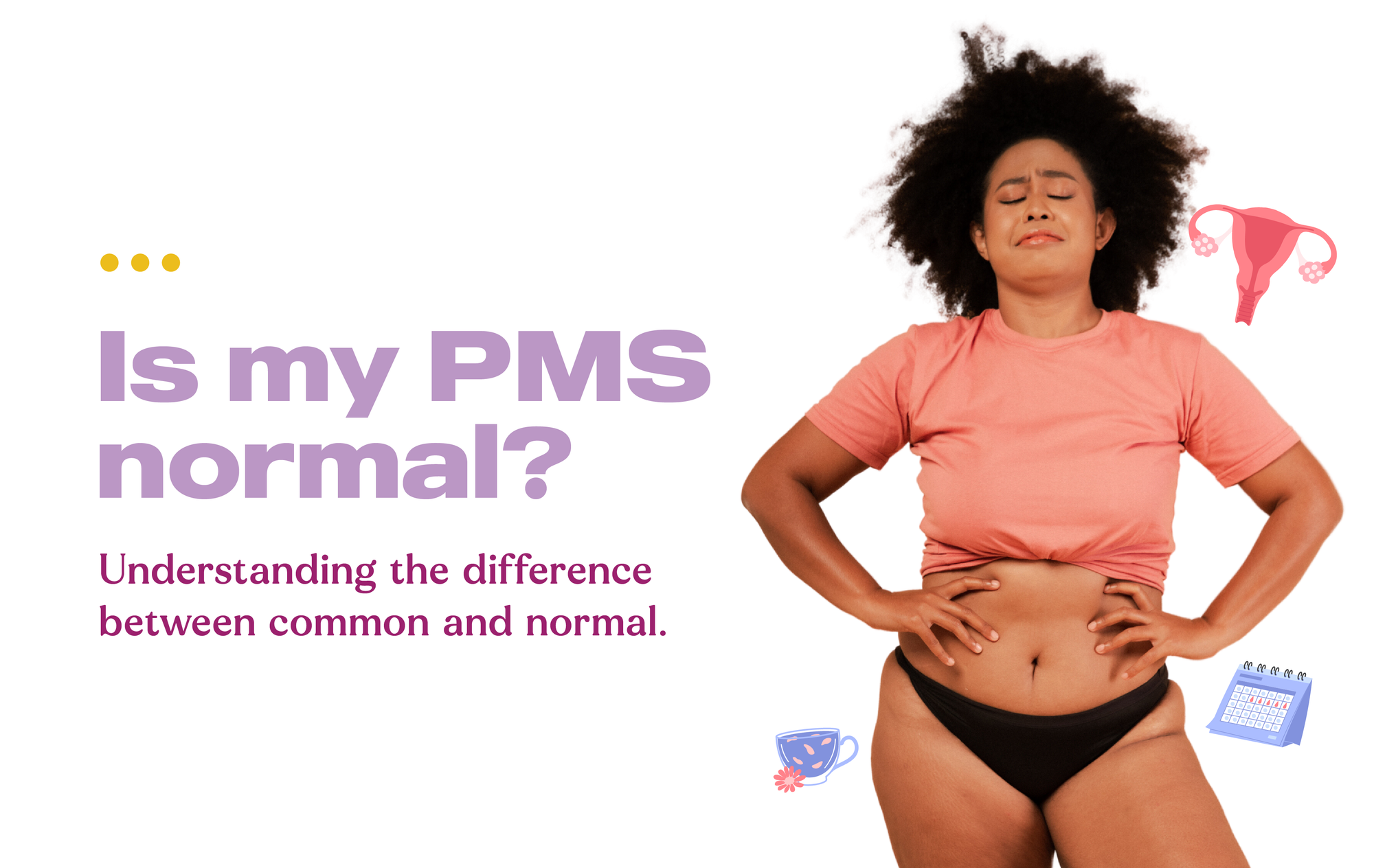
Is my PMS normal? Understanding the difference between common and normal.
by Liv Wage
PMS: the series of events that make you say, ‘ah it makes sense now’, the moment you see your period started. Some of these may include having tears when the dog commercial is on TV again, finishing an entire tub of Ben and Jerry’s in one sitting, and tender breasts that seem to not fit your bras anymore. So, this is all normal, right?
Okay, let’s just cut to the chase. Feeling a bit emotional and bloated, yes, that might be part of a healthy cycle. But disabling and severe symptoms that interfere in your daily life? No, that is not normal, and we do not have to put up with that.
What is PMS?
Premenstrual syndrome (PMS) is a set of physical and emotional symptoms that menstruators can experience 1-2 weeks before their period, until menstruation starts. The symptoms of PMS vary from person to person and can be influenced by many different factors. Over 150 symptoms related to PMS have been identified. Physical symptoms can include bloating, breast tenderness, headaches, cramps, and fatigue. Mental symptoms may be mood swings, irritability, anxiety, and depression.
So, then what is PMDD?
If PMS is the queen of period discomfort, PMDD is the empress. PMDD is the stepsister in Cinderella. PMDD stands for Premenstrual Dysphoric Disorder and affects around 5% of women worldwide. The key difference between PMS and PMDD is the severity of the emotional symptoms. While both conditions can cause physical symptoms like bloating, cramping, and breast tenderness, PMDD can lead to severe depression, anxiety, and anger that can significantly affect daily life. This is just to clarify if you might have come across this term as they both are part of the same family.
How common is PMS?
Studies estimate that as many as 3 out of 4 women experience some form of premenstrual syndrome.
It is normal for your body to signal to you that your period is about to arrive. However, when these symptoms start to become severe and impair your daily-life functioning, she might be trying to tell you something. This is when we start talking about PMS/PMDD. This is no longer normal and should not be dismissed as such.
What is PMS caused by?
As mentioned, the signs and symptoms of PMS/PMDD can range in severity, as they are caused by an orchestra of many different factors. The exact cause of PMS is unknown, but a lot of things point to our hormones.
During our menstrual cycle, hormones fluctuate. During the luteal phase, the second half of your cycle, estrogen is highly present. These fluctuations also have an impact on the brain and may affect the neurotransmitters (chemical messengers that influence our emotions) released.
Hormonal imbalance may make these symptoms more severe, which can lead menstruators to suffer from PMS/PMDD. Other factors that can contribute to PMS include stress, poor diet, lack of exercise, and underlying medical conditions.
How can PMS symptoms be reduced?
Firstly, when you think you might have PMS/PMDD, we advise you to reach out to medical professionals to discuss your symptoms.
We at Perfect Fit believe women have long been conditioned to believe that pain and discomfort is a normal part of your cycle. Invisibility of menstrual health and lack of awareness has resulted in menstruators suffering for too long. Let’s take control over our bodies again!
These are some things you can do yourself to alleviate some of the discomfort experienced before your period starts.
Some lifestyle changes you can think of incorporating into your life:
- Track your menstrual cycle. Awareness of how your body feels during different phases of your cycle can make you more mindful. This is the first step in reducing any PMS symptoms you may experience! We strongly advise you to start tracking your cycle.
- Eat a healthy, balanced diet including veggies, beans, tofu/tempeh, fish, healthy jamu, and fruits. Reduce processed food, fast food and high sugar drinks.
- Exercise regularly! If you live a stressful life, try also to incorporate some low intensity exercise, such as yoga or outdoor walks.
- Take over-the-counter medication such as paracetamol or ibuprofen to help with pain management.
If you feel like these do not help or may not be impactful enough, we advise you to reach out to a medical professional. Together you will be able to assess your symptoms and come up with a plan that might work for you!
These are some of the treatments that a medical professional might advise you to reduce your symptoms:
- Hormonal medicine, such as the contraceptive pill, might help with symptoms by regulating hormone levels.
- Antidepressants.
- Dietary supplements.
- Cognitive behavioral therapy.
Although menstruation might in some ways be uncomfortable, we at Perfect Fit believe that no woman should be limited by her period. Reach out for help when you need it! Your body should work with you, not against you.
This information is for education purposes only. If you think you might need medical advice, please reach out to a professional. This article is not intended to diagnose, treat, cure or prevent any condition. We leave that to the trained medics!
Sources
https://www.hopkinsmedicine.org/health/conditions-and-diseases/premenstrual-syndrome-pms
https://www.pixiecup.com/blog/pms-symptoms/
